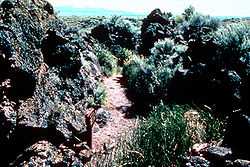Captain Jack's Stronghold
|
Captain Jack's Stronghold | |
 | |
|
Captain Jack's Stronghold | |
 | |
| Nearest city | Tulelake, California |
|---|---|
| Coordinates | 41°49′18″N 121°30′18″W / 41.82167°N 121.50500°WCoordinates: 41°49′18″N 121°30′18″W / 41.82167°N 121.50500°W |
| Area | 460 acres (190 ha) |
| Built | 1873 |
| Governing body | National Park Service |
| NRHP Reference # | 73000259[2] |
| CHISL # | 9[1] |
| Added to NRHP | September 20, 1973 |
Captain Jack's Stronghold, named for Modoc chief Captain Jack, is a part of Lava Beds National Monument. The stronghold can be accessed from the Perez turnoff, off Highway 139 between Tulelake and Canby, California.
During the Modoc War, Captain Jack's band settled here following the Battle of Lost River, and held off a United States Army force outnumbering them by as much as 10 to 1 for several months. The lava beds made an outstanding stronghold for the Modocs because of the rough terrain, rocks that could be used in fortification, and irregular pathways to evade pursuers.
In the First Battle of the Stronghold, January 17, 1873, 51 Modoc warriors defeated an Army force of 225 soldiers supported by 104 Oregon and California volunteers,[3] killing 35 and wounding several others, while suffering no casualties or serious woundings. During the Second Battle of the Stronghold, April 15 - 17, the reinforced Army of over six hundred men captured the Modoc spring and cut off their route to Tulelake, forcing the Modoc to flee when their water supplies ran out. After fleeing the Stronghold, the band of Modoc splintered, and the last group, made up of Captain Jack, John Schonchin, Black Jim, and Boston Charley were captured on June 1, 1873. All four were hanged on October 3, 1873, at Fort Klamath.
The area originally served as a hunting and gathering area.
Gallery
-

Modoc warriors defending the Stronghold
References
- ↑ 1.0 1.1 "Captain Jack's Stronghold". Office of Historical Preservation, California State Parks. Retrieved 2012-10-14.
- ↑ "National Register Information System". National Register of Historic Places. National Park Service. 2009-03-13.
- ↑ Brown, D: "Bury My Heart At Wounded Knee", page 219. Holt, Rinehart & Winston Inc, 1970.
| Wikimedia Commons has media related to Captain Jack's Stronghold. |
| |||||||||||
| ||||||||||||||||||||